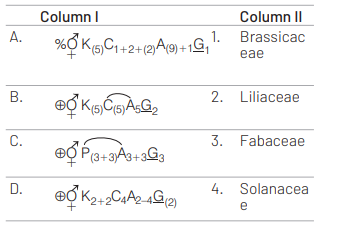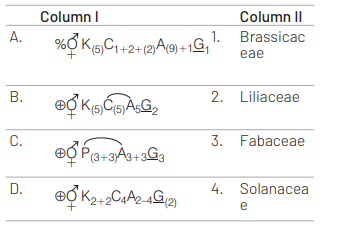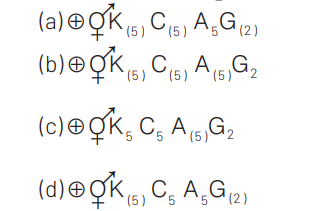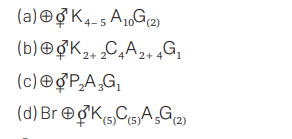Question
Match the Column -I with Column -II. [NEET 2021]

Select the correct answer from the options given below.
$\begin{array}{lllll}A & \text { A } & \text { C } & \text { D }\end{array}$
(a) $\begin{array}{llll}3 & 4 & 2 & 1\end{array}$
(b) $12 \quad 3 \quad 4$
(c) $\begin{array}{llll}2 & 3 & 4 & 1\end{array}$
(d) $4 \quad 2 \quad 1 \quad 3$
Answer/Explanation
Ans. (a)
(A) $-(3),(\mathrm{B})-(4),(\mathrm{C})-(2),(\mathrm{D} H(1)$
Fabaceae was earlier called
Papilionoideae. Flowers of Fabaceae are zygomorphic (\%),
hermaphrodite $(\mathcal{O})$, have 5 fused
sepals $\left(K_{k F \mid}\right)$,
have 5 petals out of which 2 are fused $(1+2+(2))$ have 9 united stamens and 1 free stamen $(C 9)+1$ ) and have 1 superior ovary $\left.\underline{G}_1\right]$.
This way the floral formula is made and thus, similarly for Brassicaceae, Liliaceae and Solanaceae.
Question
Which of the following is the correct floral formula of Liliaceae? [NEET (Oct.) 2020]

Answer/Explanation
Ans. (c)
Floral formula of Liliaceae is

It represents bracteate, actinomorphic, bisexual flowers having six tepals and six epitepalous stamens. Ovary is superior with three lobed stigma.
Question
Vexillary aestivation is characteristic of the family [CBSE AIPMT 2012]
(a) Fabaceae
(b) Asteraceae
(c) Solanaceae
(d) Brassicaceae
Answer/Explanation
Ans. (a)
Vexillary aestivation of corolla is a characteristic of family-Fabaceae. In corolla, the posterior petal called vexillum is largest, two lateral, curved petals are called wings and two anterior, boat-shaped petals are called keels.
Question
The correct floral formula of chilli is [CBSE AIPMT 2011]

Answer/Explanation
Ans. (a)
Floral formula of chilli (Capsicum annum) is $\oplus Q_{+} \mathrm{K}_{(5)} C_{(5)} A_5 G_{(2)}$. It belongs to family-Solanaceae. In this family. flower is actinomorphic, complete and bisexual, calyx has five sepals which are gamosepalous showing valvate aestivation, corolla has five petals which are polypetalous showing valvate aestivation, androecium has five free stamens(polyandrous) but epipetalous, gynoecium is bicarpellary, syncarpous, bilocular with superior ovary having axile placentation.
Question
Which of the following is a correct pair? [CBSE AIPMT 2002]
(a) Cuscuta – Parasite
(b) Dischidia – Insectivorous
(c) Opuntia – Predator
(d) Capseila – Hydrophyte
Answer/Explanation
Ans. (a)
Cuscuta, commonly known as dodder or amarbel, is a parasitic plant. It belongs to order Solanales and family-Convolvulaceae.
Question
Match the following and indicate which is correct? [CBSE AIPMT 2000]
(a) Cucurbitaceae – Orange
(b) Malvaceae $-$ Cotton
(c) Brassicaceae – Wheat
(d) Leguminosae – Sunflower
Answer/Explanation
Ans. (b)
Sunflower belongs to Asteraceae
(Compositae), orange to Rutaceae wheat to Poaceae (Gramineae) while cotton (Gossypium) belongs to Malvaceae.
Question
Tetradynamous stamens are found in family [CBSE AIPMT 1995, 2001]
(a) Malvaceae
(b) Solanaceae
(c) Cruciferae
(d) Liliaceae
Answer/Explanation
Ans. (c)
Tetradynamous stamens refer to four long and two short stamens arranged in a flower, e.g. members of Cruciferae (Brassica).
Question
Pulses are obtained from [CBSE AIPMT 1993]
(a) Fabaceae
(b) Asteraceae
(c) Poaceae
(d) Solanaceae
Answer/Explanation
Ans. (a)
Fabaceae (Leguminaceae) is economically important family containing a number of legumes or pulses, e.g. gram (Cicer arietinum), green gram (Vigna radiata), black gram (Phaseolus mungo), pigeon pea (Cajanus cajan), soyabean, etc.
Question
Epipetalous and syngenesious stamens oCCUr in [CBSE AIPMT 1991]
(a) Solanaceae
(b) Brassicaceae
(c) Fabaceae
(d) Asteraceae
Answer/Explanation
Ans. (d)
In disc florets of family-Asteraceae (Compositae), androecium consists of five stamens, which are epipetalous, with free filaments and fused anthers (e.g. syngenesious), dithecous, introse and dehiscing longitudinally.
Question
Botanical name of cauliflower is [CBSE AIPMT 1991]
(a) Brassica oleracea var. capitata
(b) Brassica campestris
(c) Brassica oleracea var. botrytis
(d) Brassica oleracea var. gemmifera
Answer/Explanation
Ans. (c)
Brassica oleracea var. botrytis
(cauliflower $=$ phulgobhi), B. oleraceavar. capitata (cabbage $=$ bandgobhi), $B$. oleraceavar. caulorapa(knol khol = ganth gobhi), B. campestris var. sarson (yellow mustard) B. rapa (turnip).
Question
Floral formula of tomato/tobacco is [CBSE AIPMT 1989, 92]
Answer/Explanation
Ans. (d)
Tomato and tobacco are the members of family-Solanaceae, with floral formula
